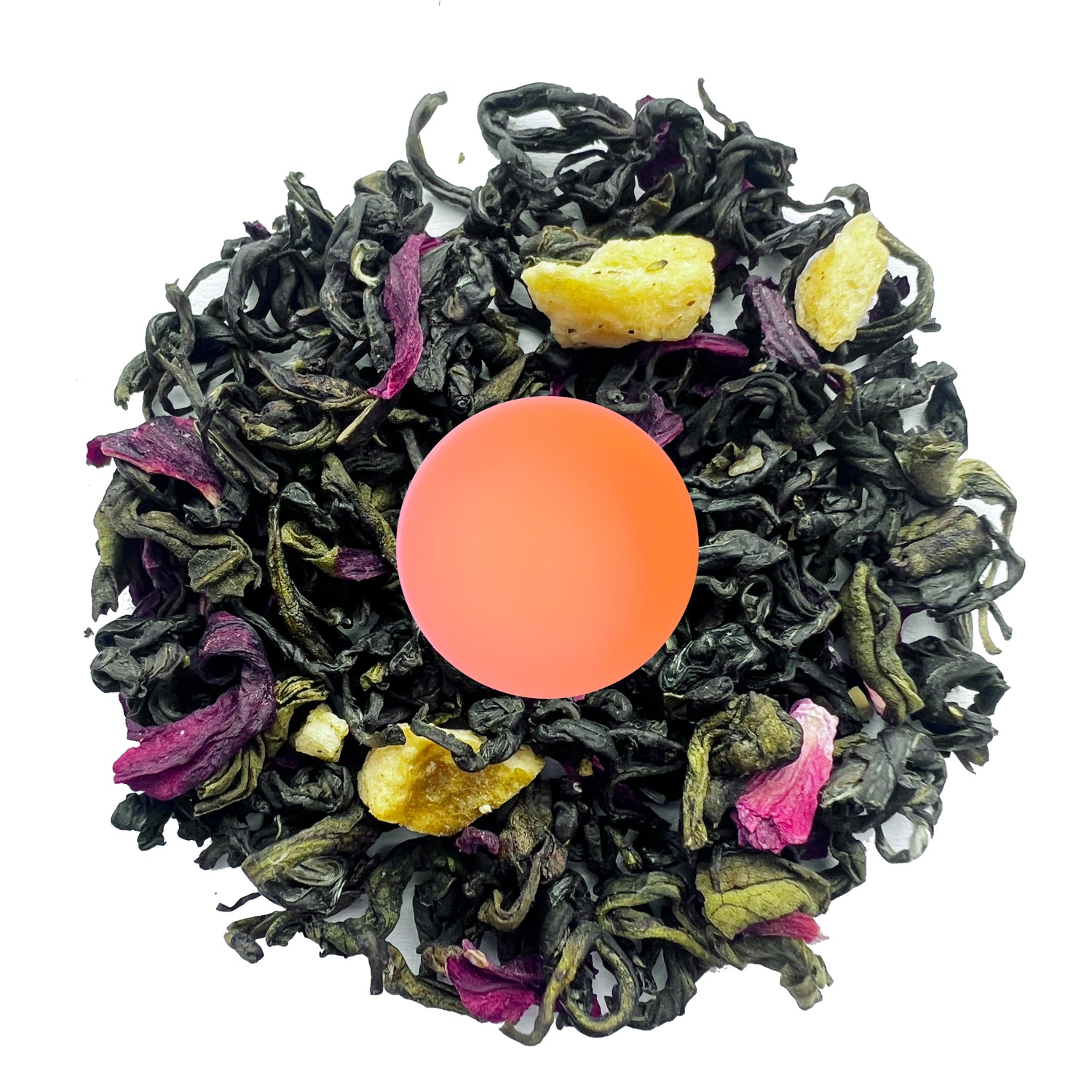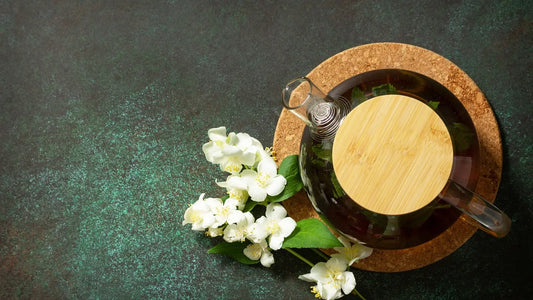Loose-Leaf Teas: Everything You Need to Know

Most of us drink tea on a regular basis and use tea bags or CTC tea powder to make our tea. But, did you know that loose-leaf teas have richer flavors than packaged teas?
For beginners, navigating the world of loose-leaf tea can be a bit daunting. So, to help you get started, we’ve included everything you need to know about this tea.
Well, loose-leaf tea might just be your new favorite. So, keep reading!
What is loose-leaf tea?
As the name implies, loose-leaf tea is the whole or broken tea leaves that come in boxes or containers. It isn’t crushed or packed in tea bags like the CTC teas.
The loose leaves preserve the essential oils, aroma, and nutritional properties. That’s why this tea offers a richer and higher-quality tea experience to drinkers.
Usually, people drink this tea by steeping loose leaves into the warm water for a few minutes. But, there are also other ways you could enjoy this tea.
History of Loose-Leaf Tea
Around 5000 years ago, loose-leaf teas were processed by compressing leaves into tea bricks or cakes in China.
Originally used for medicinal reasons, this tea still remains superior in the cultural tea ceremonies of some countries. For instance, Gongfu tea in China, Chanoyu in Japan, or afternoon tea in Britain.
Nonetheless, loose-leaf tea is commonly enjoyed by tea enthusiasts worldwide for its exceptional premium flavors.
Loose-Leaf Tea for Beginners
You can find an extensive range of loose-leaf tea variants ranging from orthodox teas, and herbal teas to fruit-blended teas. Each tea type undergoes a different processing. Some loose-leaf tea may be roasted, while others could be steamed or dried.
Now, if you're a beginner, you may be in a dilemma in picking a loose-leaf tea for you.
But, don’t worry! We’ve compiled a list of the best loose-leaf tea types with their flavor profiles to ease your decision. Let’s get right into it!
Orthodox Loose-Leaf Teas
First, we have orthodox teas originating from the Camellia Sinensis plant. They are all black tea, white tea, oolong tea, and green tea. These teas are called orthodox because they undergo labor-intensive processing like hand-plucking leaves, withering, oxidation, drying, and so on.
Here’s a brief overview of what each type of orthodox tea offers.
- Black Loose-Leaf Tea:
Black loose-leaf tea, which is 100% oxidized, gives off a bold and rich flavor. Depending on the quality, the taste profile could be malty or astringent.
Generally, these teas are so strong that you could steep them several times and still get a robust flavor. It’s also considered to have the highest caffeine amount.
If you’d like to try out loose-leaf black teas, you could check out Assam, Darjeeling, and Danfe Tea.
- Oolong Loose-Leaf Tea:
Oolong loose-leaf teas are slightly mild compared to black tea, but stronger than green tea. Basically, as these teas are oxidized only by a few percent, it has a very sophisticated taste.
However, it also relies on how the teas are processed. Some oolong loose-leaf teas could have a floral flavor, while others could be biscuity.
Popular options for oolong loose-leaf teas are Tie Guan Yin, Dong Ding, etc.
- Green Loose-Leaf Tea:
The unoxidized teas are called green tea. This green loose-leaf tea offers a very delicate taste with a grassy and vegetal flavor. You may experience a sweet or astringent taste, based on the type of green loose-leaf tea you pick.
If you’re interested, Sencha and Dragonwell are the two best organic loose-leaf green teas. Or, try the flavored loose-leaf green jasmine tea.
- White Loose-Leaf Tea:
White loose-leaf tea, which undergoes a very minimal process, has the most delicate tea profile. You may get notes of floral, honey, and fruity flavor while drinking this tea.
You could start with a silver needle or white peony white loose-leaf tea.
Herbal Loose-Leaf Teas
In case you do not want caffeine in your tea, you could opt for herbal loose-leaf teas. These teas are made simply out of dried herbs, flowers, and spices. It might also be a better choice for someone who wants a soothing and calming effect in their tea experience.
The taste profile of herbal loose-leaf teas differs as per the type. Peppermint tea has a cool and minty flavor. Similarly, loose-leaf chamomile tea offers a sweet and floral taste with a hint of apple notes.
You may try out these best herbal loose-leaf teas like lavender, hibiscus, rooibos, ginger, peppermint, chamomile, loose-leaf dandelion tea etc.
Fruit-Blended Loose-Leaf Teas
Next, for a more flavorful experience, you could explore fruit-blended loose-leaf teas. This tea is a mixture of tea leaves, dried fruits, spices, flowers, etc. It offers a more fruity, floral, and sweeter taste profile.
Fruit-blended loose-leaf teas also usually do not contain caffeine. But, if it's infused with orthodox tea, it may have a certain quantity.
If you want to try, check out any one of these exciting flavors like loose-leaf peach tea, raspberry loose-leaf tea, hibiscus-based, apple-based, berry blends, or peach and mango blends.
Dessert Teas
Do you have a sweet tooth? It’s because there are teas that offer the taste of dessert or baked items.
Dessert teas could also be a better option for someone who’s not fond of the bitter taste profile of the tea. Some popular tea flavors include chocolate, vanilla, caramel, red velvet cake, cinnamon bun, nuts, etc.
Loose-Leaf Tea by Origin
For those who want to taste loose-leaf tea by origin, you could try Darjeeling loose-leaf tea, Chinese loose-leaf tea, Japanese loose-leaf tea, and Nepali loose-leaf tea.
Teas from each region significantly influence the flavor profile and quality. So, you could explore the unique tea experience from all around the world.

How to brew loose-leaf tea?
Many people tend to have a misconception that brewing loose-leaf tea is complicated. But, it's just as simple as preparing your drink with a tea bag.
Below, we have given very easy instructions to make a cup (8 fl oz) of loose-leaf tea. However, we strongly recommend you have your own personal tea-drinking experience. Add flavors, twist the brewing style, and personalize your brew. That’s where the real joy is!
You’ll need
- 1-2 teaspoons of loose-leaf tea
- Tea infuser or a teapot
- Strainer
- Teacup
- Filtered water
Instructions
- Boil the filtered water.
- Put 1-2 teaspoons of loose-leaf tea into the tea infuser for the teapot.
- Now, pour the boiling water over the tea leaves.
- Close the lid of the teapot.
- Let the leaves steep for some time (3-5 minutes).
- If needed, strain the tea leaves.
- Then, pour the tea into your cup. You may serve as it is or put in more flavors to enhance the taste
Well, that’s how the hot loose-leaf tea is made. You may also enjoy cold brewing loose-leaf tea. For that, use a large serving size of tea leaves - around 40% tea and 60% water. Steep the tea in cold water for 16-24 hours, in a refrigerator or at room temperature.
Additional Tip for beginners
- Boiling (100 ° Celcius) water might not be suitable for all types of tea. It could burn the tea leaves that are delicate in nature such as white tea.
- The steep time and water temperature could be different to get the best flavor for each tea type.
- Try storing the tea leaves in an airtight container.
Best Loose-Leaf Tea Brands
To brew your loose-leaf tea, first pick the high-quality tea. Here are some of the top loose-leaf tea brands you can choose from.
- Tucson Tea Company - loose-leaf tea
- Ceylon loose-leaf tea
- Twinings loose-leaf tea
- Lady Gray loose-leaf tea
- Mullein loose-leaf tea
- Danfe Tea
- Lipton loose-leaf black tea

Benefits of Loose-Leaf Tea
May Decrease Blood Sugar Level
loose-leaf tea is rich in polyphenols that may help to maintain the blood sugar level. A study in the British Journal of Nutrition reported that drinking tea enhances glucose metabolism, resulting in a decrease in the blood sugar level.
Protection from Cell Damage
The National Center for Complementary and Integrative Health (NCCIH) has cited that polyphenols in loose-leaf tea might help to protect cells from damage. The antioxidant property in loose-leaf tea may also minimize the risk of chronic disease.
Promotes Weight Loss
Drinking loose-leaf tea, especially green tea, may help in weight loss. According to the American Journal of Clinical Nutrition, green tea extract enhances fat oxidation which results in loss of body weight.
Improves Digestive Health
Herbal loose-leaf tea may improve digestive health by relieving the gastrointestinal problem. The research found that drinking peppermint tea could soothe irritable bowel syndrome symptoms.
May Improve Skin
loose-leaf teas also contain anti-inflammatory and antioxidant properties that might be useful in protecting skin against UV damage. It may help in improving the skin.

Loose-Leaf Teas FAQs
Can you bring loose-leaf tea on a plane?
According to the TSA (Transportation Security Administration), you’re allowed to carry loose-leaf tea on a plane. But, you might have to pay attention to the tea packaging and quantity restrictions.
How long does loose-leaf tea stay good?
If stored properly, loose-leaf tea could remain fresh from 6 months to 2 years. But, the shelf life of loose-leaf tea depends on the storage conditions, oxidation, packaging, and freshness. We recommend you check the packaging to know the expiry date from the manufacturers.
How long does it take to steep loose-leaf black tea?
Usually, the steep time for the loose-leaf black tea ranges between 3 to 5 minutes. But, there’s no strict time to brew your tea. If you want a stronger flavor, infuse your tea longer. Or, simply shorten the steep time for a milder and delicate taste.
How much caffeine is in loose leaf black tea?
In loose leaf black tea, the average caffeine content could vary from 30 - 60 mg.
How much loose leaf black tea per cup?
It’s up to you to estimate the quantity of loose leaf black tea as per your serving size and the preferred flavor. Usually, in 1 cup (8 fl oz), 1 teaspoon should be enough. But, again if you want a stronger brew, you may put 1.5 to 2 teaspoons.
How to store loose-leaf tea?
Usually, the loose-leaf teas are stored in an airtight container, away from the freezer or direct sunlight. Try to store it in the pantry and avoid placing tea near strong odors. You could also look into the packaging of loose-leaf tea for instructions from the manufacturers.
What is the best loose leaf black tea?
Some best loose leaf black teas are Assam, Darjeeling, Ceylon, English breakfast, Danfe tea, and lapsang souchong. These teas are of high quality and offer a rich taste.
How to make loose-leaf tea without a strainer?
In case you do not have a strainer, you could try using other alternative tools like a french press, or sieve. Or, you could simply use the double cup technique, steep tea in one cup and serve in another.
How to brew loose-leaf tea without an infuser?
For those who do not have an infuser, you may steep the loose-leaf tea in the cup itself or a kettle. Then, strain the tea leaves afterward.
How to make iced tea using loose-leaf tea?
To make iced tea using loose-leaf tea, steep the tea in warm water of about 180 - 200 degrees Fahrenheit. After steeping for 3- 7 minutes, strain your tea and pour it into a cup. Refrigerate the tea and put ice cubes to enjoy your iced tea.

Conclusion
In comparison to tea bags and CTC tea, loose-leaf tea definitely provides a premium tea quality experience. It has a superior flavor, aroma, and brewing control, including the health benefits.
Get connected with our Danfe Tea and indulge yourself with our extensive range of loose-leaf teas. From black tea to herbal teas, we offer the finest quality loose-leaf tea from the Himalayas.
If you’d like to taste different flavors, we also have a loose-leaf tea assortment box. Check out our Himalayas loose-leaf tea Sampler variety pack.








